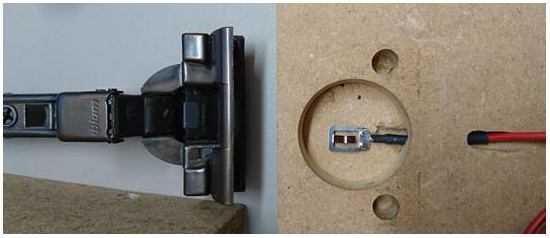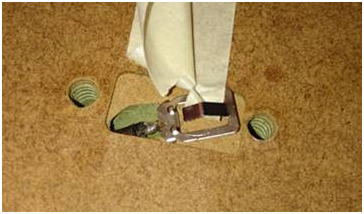I'm working on a site in the UK where a joinery company will be installing bespoke vanity cabinets.
The cabinets will have MDF/mirrored doors with a demista (heated pad) laminated between the mirror and the MDF door.
The Demista is powered by a 24v SELV transformer, located behind a small panel in the cabinet, in the normal way.
There is a cable, run from the transformer, via a routing, into a tiny pocket behind the Blum hinge mounting plate, in the cabinet side.
The cable is terminated with a spring connector, which is clamped by the Blum hinge mounting plate, see attachment mountingplate.png
There is a corresponding cable and spring connector in the 35mm round drilling for the actual Blum hinge, which would be clamped by the hinge - see attachment hingeplate.png
The 24v power for the demista is intended to flow through the hinge itself - the actual metal body of the Blum hinge will be energised with 24v, from the SELV transformer.
The hinge at the top of the door would be positive and the hinge at the bottom would be negative from the SELV transformer.
The hinges are around 80cm apart.
The door itself will be lacquered MDF.
There is a lot of debate at the moment over the acceptability of using the exposed metal body of the hinge as a conductor.
The on-site electrician doesn't have a problem with it, but I am just slightly uncomfortable.
Does this comply with UK regs?
If it doesn't, please can someone point me in the direction of the regulations it contravenes?
Many thanks in advance!
The cabinets will have MDF/mirrored doors with a demista (heated pad) laminated between the mirror and the MDF door.
The Demista is powered by a 24v SELV transformer, located behind a small panel in the cabinet, in the normal way.
There is a cable, run from the transformer, via a routing, into a tiny pocket behind the Blum hinge mounting plate, in the cabinet side.
The cable is terminated with a spring connector, which is clamped by the Blum hinge mounting plate, see attachment mountingplate.png
There is a corresponding cable and spring connector in the 35mm round drilling for the actual Blum hinge, which would be clamped by the hinge - see attachment hingeplate.png
The 24v power for the demista is intended to flow through the hinge itself - the actual metal body of the Blum hinge will be energised with 24v, from the SELV transformer.
The hinge at the top of the door would be positive and the hinge at the bottom would be negative from the SELV transformer.
The hinges are around 80cm apart.
The door itself will be lacquered MDF.
There is a lot of debate at the moment over the acceptability of using the exposed metal body of the hinge as a conductor.
The on-site electrician doesn't have a problem with it, but I am just slightly uncomfortable.
Does this comply with UK regs?
If it doesn't, please can someone point me in the direction of the regulations it contravenes?
Many thanks in advance!











